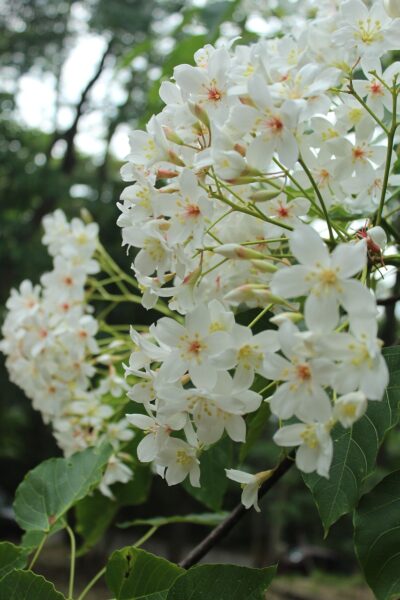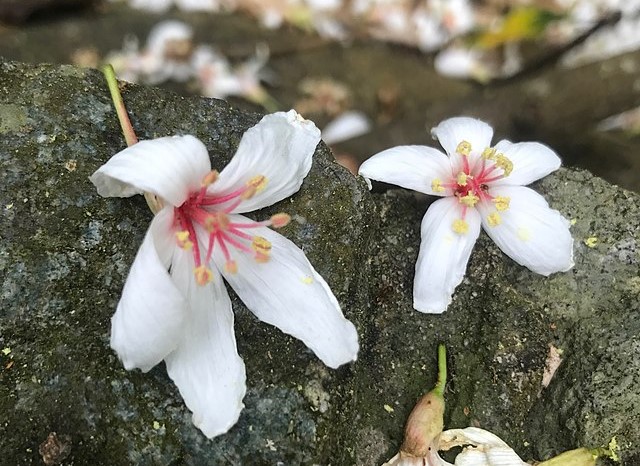
During Japan’s 1895-1945 occupation of Taiwan, hundreds of thousands of tung oil trees were planted in Hsinchu and Miaoli counties. The colonial authorities wanted both the wood (which is light and good for making furniture, matches, and toothpicks) and the oil that can be extracted from its seeds. Between the world wars, Japanese industry used the oil as an ingredient in caulk, paint, and varnish, or to finish wooden objects.
From commodity to decoration
Just as the invention of synthetic oils undermined Taiwan’s camphor industry, cheaper manmade alternatives to tung oil eventually caused the abandonment of most of the plantation. The trees, of course, didn’t disappear. Because they grow so well in Taiwan, they continued to thrive and spread. And countryside people went on using the wood to build their houses, fences, and chicken sheds.
The areas in which tung oil trees grow well happen to be dominated by Hakka people, one of Taiwan’s non-indigenous cultural and linguistic minorities. Hakka communities have always felt grateful for the trees because their oil helped them earn money at a time when the majority of Taiwanese lived at subsistence levels. What’s more, they’ve embraced the tree as a symbol of the local Hakka population. Much like the Hakka pioneers who entered the northwest’s hill country more than 200 years ago, the trees established themselves despite adverse conditions. It’s even said that the more barren the soil, the more beautiful the white flowers.
Tung trees typically flower three times each year. The blooms of late summer are often lost in that season’s thunderstorms and typhoons, while those which appear in December seldom last long due to the cold. But when spring starts to warm up in the northwest, the flowers persist in such numbers that, from a distance, a slope covered with tung oil trees can look like a woodland that’s been dusted with snow. For Taiwanese people — who seldom get to see snow in their own country — this is obviously a special sight. The kind of world traveler Life of Taiwan often hosts is familiar with snow; even so, for many visitors it’s a delight akin to viewing Japan’s sakura (cherry blossoms).
Tung blossom viewing is a good starting point for a meaningful exploration of an undertouristed region that offers enchanting scenery and a rewarding blend of rich cultural experiences, fine food, and just the right tempo for true relaxation. This April will see the launch of the 2024 Tung Blossom Festival. As usual, it involves much more than appreciating tung flowers. In addition to performances of Hakka music and dances, there will be religious ceremonies in honour of the Three Mountain Kings, a trio of deities worshipped by Hakka people in Taiwan, China, and Southeast Asia.
Woodcarvings and Hakka heritage
Whatever the season, the Miaoli town of Sanyi deserves at least a few hours. Regarded as Taiwan’s woodcarving centre, Sanyi boasts a fascinating Wood Sculpture Museum and more than a dozen showroom-galleries in which local artists display and sell their works. If museums are your thing, there’s also the Taiwan Hakka Museum, 15 minutes away by car. The latter introduces some of the trades Hakka people traditionally engaged in, for instance extracting camphor deep in the mountains, producing citronella oil, growing tea, and cultivating tobacco.
Of course, not every visitor to Taiwan has enough time to explore beyond Greater Taipei. If that’s the situation you find yourself in — but a combination of tung blossoms, fresh air, and easy exercise appeal to you — think about spending a couple of hours hiking the Tucheng Tung Blossom Trail or the Yang Chou Keng Forest Trail. The beginning of the former is within walking distance of Yongning Station on the Taipei Metro’s Blue Line; the latter is in Taoyuan’s Lujhu District, a short taxi ride from Shanbi Station on the Taoyuan Airport MRT line.
Whether your interest lies in glorious flowers and blossoms or Taiwan’s remarkable religious culture, Life of Taiwan’s expert itinerary designers can plan out a private tour of Taiwan that’ll make the most of your stay and leave you with cherished memories. Contact us today!

